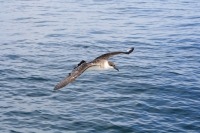
(Photo: Tracey Dean)
Great Shearwater
Ardenna gravis
Great shearwaters can be recognized by their distinctive colouring. They have a dark cap, brown belly patch, and white underwings. The feathers on their brown back and wings have a pale edge, giving the wings a scaled appearance. Their wingspan can be up to 118 centimetres, and it can weigh up to 1.1 kilograms.
Authority
O'Reilly, 1818
Classification Details
Phylum: Chordata (chordates); Subphylum: Vertebrata (vertebrates); Class: Aves (birds).
Habitat
One of the most widespread seabirds found throughout many of the world's oceans. Typically found over cool offshore waters. It breeds on isolated islands in the South Atlantic. It moves north from these in April and May, travelling up to Newfoundland and Greenland. It then travels back south between August and November and after this is found off Brazil, in the SW Indian Ocean, and around South Georgia. It may travel to other places too - even as far as New Zealand.
Diet
Predator. Mainly eats fish, squid, and some crustaceans. Captures prey by plunge diving from six to ten metres above the sea. Most dives are shallow (under 2 metres depth) but can be up to 18.9 metres. It may follow fishing trawlers to feed on the discarded chum.
Reproduction
The great shearwater breeds on the isolated islands of the Tristan da Cunha group in the South Atlantic. There is also a tiny colony on Kidney Island in the Falkland Islands. Birds return to breeding colonies in September. They nest in burrows up to 1.5 metres long. Pairs form long-term bonds with each other. The female lays one egg at a time, which hatches after 53 to 57 days. Both parents feed the chick. Chicks leave the nest after about three months. This species can live for at least 25 years.
Fun Facts
Terrestrial mammals used to be absent from the Tristan da Cunha group, but sealers introduced house mice in the 19th Century. Mice there grow to almost twice as large as those found elsewhere. These giant mice eat chicks and eggs. They have a significant impact on bird populations. Conservationists are trying to eradicate the mice.
Researchers from Grand Manan Whale and Seabird Research Station (New Brunswick, Canada) tagged great shearwaters to see where and how far they travelled. A bird they called “Swain,” after one of the families that lives on Tristan, travelled over 32 827 kilometres in one year.
References
Carboneras C, Jutglar F and Kirwan GM (2020). Great Shearwater (Ardenna gravis), version 1.0. In Birds of the World (J. del Hoyo, A. Elliott, J. Sargatal, D. A. Christie, and E. de Juana, Editors). Cornell Lab of Ornithology, Ithaca, NY, USA. https://doi.org/10.2173/bow.greshe.01 Caravaggi A, Cuthbert RJ, Ryan PG, Cooper J and Bond AL (2019) The impacts of introduced House Mice on the breeding success of nesting seabirds on Gough Island. Ibis 161, 648-661 https://doi.org/10.1111/ibi.12664 Ronconi R (2007) The Spectacular migration of greater shearwaters. Birdwatch Canada Special Report 39, 1-4. Ronconi RA, Ryan PG and Ropert-Coudert Y (2010) Diving of Great Shearwaters (Puffinus gravis) in Cold and Warm Water Regions of the South Atlantic Ocean. PLoS ONE 5(11): e15508. doi:10.1371/journal.pone.0015508 Tristan da Cunha Government (2015) The Great Shearwater. https://www.tristandc.com/wildgreatshearwater.php#bottom. Accessed online 20 May 2021.

